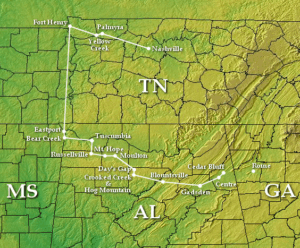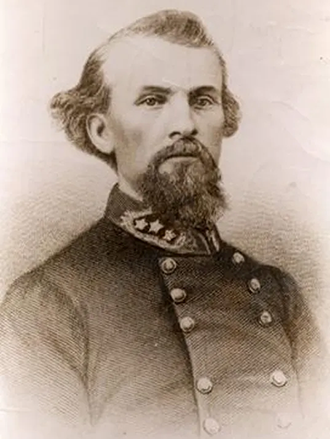A BGES Civil War Field University Program
With Norman Dasinger
February 20-22, 2026; from Gadsden, AL

In April 1863, while Union operations in the Western Theater lagged and Confederate raids threatened Federal supply lines, Union Gen. William S. Rosecrans ordered Col. Abel Streight to lead a fast-moving raid into northern Alabama and Georgia to cut the Western & Atlantic Railroad between Chattanooga and Atlanta.
Streight’s column would move east from northeast Mississippi while Brig. Gen. Grenville Dodge struck Tuscumbia, Alabama, as a diversion. More than 2,000 mounted Union troopers—many on mules, which Streight believed were better suited to Appalachian terrain—pushed across northern Alabama toward Georgia.
The first part of the expedition went well. Dodge captured Tuscumbia, and Streight continued east toward Georgia. But on April 30, elements of Maj. Gen. Nathan Bedford Forrest’s cavalry struck Streight’s rear. The Federals set a well-laid ambush that wounded Capt. William Forrest, the general’s brother, and allowed the raid to continue.
What followed was a relentless pursuit. Operating in hostile territory, Forrest drew vital intelligence from local residents and steadily closed the distance. Near the Alabama–Georgia line, after a week on the run, Forrest confronted Streight on May 3 under a flag of truce. Though Forrest had roughly 600 men—fewer than half of Streight’s command—he deployed them to appear far stronger. Couriers from fictitious units rode in with “reports” as the two commanders parleyed. Convinced he was outnumbered, Streight surrendered—just 20 miles short of his objective at Rome, Georgia—turning over about 1,500 men to Forrest’s small truce.
How did Forrest and his men ultimately accomplish this feat? Why did a largely successful raid unravel at the last moment? What logistical and command challenges shaped each leader’s and their men face?
Join Norman Dasinger as we retrace Forrest’s pursuit of Streight across the Yellowhammer State—as Alabama is called—and examine the decisions, terrain, and tight timelines that determined the raid’s outcome.


Itinerary
Friday, February 20, 2026 – Orientation (6–7 p.m.)
Meet at the headquarters hotel for a one-hour orientation program and an overview of the tour’s sites and events. Program materials will be distributed at this time (or the following morning for late arrivals).
Dinner is on your own.
Saturday, February 21, 2026 (8 a.m.–5 p.m.)
We depart our hotel in Gadsden, Alabama, and drive across the state to Eastport, Mississippi—today submerged beneath Pickwick Lane. In 1863, this was the starting point of Col. Abel Streight’s amazing raid Alabama toward Georgia. Standing on the banks of the Tennessee River, you’ll easily envision the mules, boats, and men preparing for their daring mission.
Next, we will stop at Big Bear Creek, site of the railroad trestle where Streight first met Union Gen. Grenville Dodge. Here, the two devised their deception plan to allow Streight’s mounted infantry to slip away and begin their trek.
Next, we will stop at the Town Creek Battle site. Here, Confederate Gen. Phillip Roddey and Forrest clashed with Dodge’s 8,000 infantry, enabling Streight to move largely undetected and free of pursuit.
We will then visit the antebellum town of Courtland to consider its role in the Texas Revolution and then drive to Moulton where on April 29, 1863, Streight and his men will have their finest day — free from Forrest and enjoying the rain free cool spring weather in Alabama.
We will travel nearly the same route that both sides used to climb Brindley Mountain, arriving at the Days Gap battlefield, the site of a vicious first major encounter between Forrest and Streight. Here, Forrest’s brother was grievously wounded, two Union cannons were lost, and—for once—the famed Confederate commander was defeated. By nightfall, the armies clashed again at Hog Mountain. Thanks to preservation by the American Battlefield Trust, this beautiful battlefield retains signage and integrity. On April 30, as the sun set, Forrest failed once more to secure victory.
We will return to the hotel by 5 p.m.
Lunch is included, but dinner is on your own.
Sunday, February 22, 2026 (8 a.m.–5 p.m.)
Today, we follow the combatants to Blountsville, where weary Union troops rode into town amid May Day celebrations. Despite being harassed all night by Forrest, Streight made several smart decisions here.
Then we will view Royal Crossing on the Black Warrior River, where, finally, Streight allowed his men some rest. We will also share the story of the Murphree sisters, whose lives intersected with the raid.
On the night of May 1, Forrest’s men camped at Walnut Grove (a site still extant), while Streight bivouacked near present-day Attalla. His crossing of Wills Creek proved disastrous, though one of his subordinate officers temporarily salvaged the mission, keeping the column moving eastward toward Rome, Georgia.
We will arrive in Gadsden where we encounter one of the Civil War’s most well-known episodes: the bravery of 16-year-old Emma Sansom, honored by a monumental statue in the city. We will look around town and explore another amazing story—that of John Wisdom, the “Paul Revere of the South,” whose ride from Gadsden ultimately saved Rome.
From Gadsden, we continue to Turkeytown, with its two wartime stories, and then to Blount’s Plantation battlefield. Here, Streight nearly succeeded in ambushing Forrest, but the Confederate general anticipated the move and escaped the trap. From this point, the race for Rome intensified.
Streight pressed on through Cherokee County, Alabama, over the Chattooga River, through Cedar Bluff, and finally halted for rest at the Lawrence Farm—only a few miles from the Georgia line. There, his raid ended. Despite commanding a much smaller force, Forrest compelled Streight’s surrender. How he managed this feat will be discussed on the very ground where the two men met on May 3, 1863.
Many of the sites we visit remain virtually untouched since the 1860s, offering a rare sense of stepping directly into 1863.
We will return to the hotel by 5 p.m.
Lunch is included.
About the Faculty
 Norman Dasinger, owner of a real estate title company, has been active in Civil War history, preservation, and interpretation since 1985. He is a member of the SCV, SUVCW, and SAR and has been leading tours of Civil War sites across Alabama, Georgia, and Tennessee since 2004. Norman brings substantial knowledge of the region’s history, spanning the Civil War, pioneer settlement, Native American heritage, and the Civil Rights movement. He lives in Rainbow City, Alabama, and is the father of two grown sons.
Norman Dasinger, owner of a real estate title company, has been active in Civil War history, preservation, and interpretation since 1985. He is a member of the SCV, SUVCW, and SAR and has been leading tours of Civil War sites across Alabama, Georgia, and Tennessee since 2004. Norman brings substantial knowledge of the region’s history, spanning the Civil War, pioneer settlement, Native American heritage, and the Civil Rights movement. He lives in Rainbow City, Alabama, and is the father of two grown sons.
Hotel Information
This program will be headquartered at Fairfield Inn, 116 Walker St., Gadsden, Alabama, 35904 (256-538-2100). The BGES special rate is $119 plus tax, available until January 20, 2026. Be sure to mention the group name “Blue and Gray Education” when booking to receive the discounted rate. The hotel does not have an airport shuttle.
Transportation
The nearest airport is Birmingham-Shuttlesworth International Airport (BHM), located 53 miles from the hotel. Atlanta’s Hartsfield-Jackson International Airport (ATL) is also an option, 122 miles away.
Recommended Reading
Participants will receive maps and program materials to support onsite study. The following titles are recommended for those who wish to prepare in advance.
- Hurst, Jack. Nathan Bedford Forrest: A Biography. New York: Vintage Press, 1993. ISBN: 978-0679748304.
- Raines, Howell. Silent Cavalry: How Union Soldiers from Alabama Helped Sherman Burn Atlanta—And Then Got Written Out of History. New York: Crown, 2023. ISBN: 978-0593137758.
- Warner, Ezra J. Generals in Blue: Lives of the Union Commanders. Baton Rouge: Louisiana State University Press, 2006. ISBN: 978-0807108222.
- Willett, Robert L., Jr. The Lightning Mule Brigade: Abel Streight’s 1863 Raid into Alabama. Carmel: Guild Press of Indiana, 1999. ISBN: 978-1439219966.
Tour Pricing
Current BGES Member $575 (one-time payment, no deposit)
Non-BGES member $626 (one-time payment, no deposit)
Deposit to reserve spot: $150
Annual membership fee: $75
Registration
To register by mail or fax, download: Printable Registration Form
Questions? Need more information? Please Contact Us
